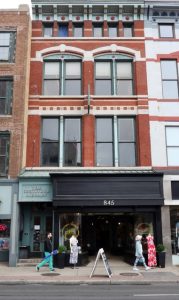 Even when you’re standing right in front of it, it’s easy to overlook the small door – squeezed between a tattoo parlor and a vintage clothing store -– that leads into The Institute Library, one of the last remaining membership libraries in North America.
Even when you’re standing right in front of it, it’s easy to overlook the small door – squeezed between a tattoo parlor and a vintage clothing store -– that leads into The Institute Library, one of the last remaining membership libraries in North America.
One hint you might be getting close is if you see a young man in a morning coat and top hat, as if straight out of a Dickens novel, approaching the building. You might wonder if you are time-traveling back a few centuries, until you notice a laptop tucked under his arm.
And, when you discover your destination right there in plain sight, you’ll need to push a doorbell and wait for a volunteer to welcome you inside the 1878 brick building, at 847 Chapel St. in New Haven, where street noises fade away. The interior is hushed and calm; a gentle place in which to escape for a little while, or as long as you’d like.
The library, located upstairs and just a block from the Green, is accessible by staircase. This enduring institution is a nod to the past – really more like a bow. Its hidden-ness is part of its mystique. Yet it is not a staid structure. In addition to its rich collection of well-preserved books – more than 30,000 volumes lining the walls from floor to ceiling – the library is a living, breathing member of the community that holds innovative, ongoing programs and changing, curated art exhibitions that are all open to the public.
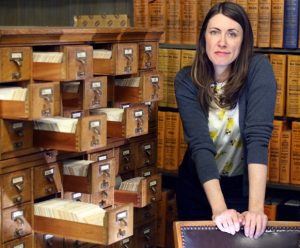
Past and Present Intertwined
In addition to being a wealth of information, Valerie Garlick is The Institute Library’s executive director and its only paid employee.
“The library’s genesis was as a place to further one’s education,” Garlick says of what was earlier known as The Young Men’s Institute Library. “The story is that eight young working class men from New Haven came together to pool their resources, share knowledge, exchange books, and have a routine debate process. They would talk philosophy, trade, etc. It started as a room in Ninth Square and grew until it eventually ended up here.”
Although women were coming to the library since its inception in 1835, Garlick says they were given a “ladies parlor” and mostly kept separate from the men.
“Men would play chess, women would have their fashion magazines, but women were allowed in and had equal standing,” she says.
In 2011, the library was incorporated as a nonprofit public charity and became known as The Institute Library.
The library predates the public library system in New Haven by 61 years and belongs to the Membership Libraries Group (MLG), which includes just 16 circulating libraries and 20 libraries in total. The Institute Library, with about 500 members, is relatively small within that group.
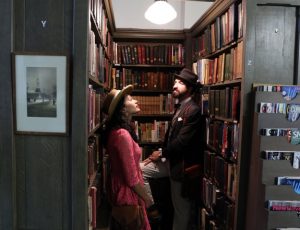
A key component to the library’s survival is dues. Memberships are $25 a year for first-time members, $60 a year for sustaining members, and $125 for patrons, with shared membership privileges at nine historic partner libraries in New York and New England. Everyone is welcome in the library, but only members can check out books.
“We’re able to curate our collections to the interests of our members and put on programs they suggest,” Garlick says. “It’s always been a little like a club, but we welcome everyone to our programs, and anyone can become a member.”
She adds: “This is a library that’s friendly for introverts. You can hide away and be comfy and read by yourself and luckily, since we’re so hidden, it’s a quiet space to tune out – that’s really important to us.”
She recalls that when she became executive director two years ago and put a computer on the front desk to check books in and out, some people were rubbed the wrong way. Since then, she says, “people understand that we’re putting our books online where they can learn more about our collection, what people are reading. They appreciate that we have Wi-Fi.”
Garlick thinks people become members of the library for reasons that are more cerebral than low-tech versus high tech.
“People want a philosophical forum to come have conversations, discuss ideas, or quietly do research on their own,” she says. “And it’s a place to gather in real time. People have a hunger for that, which is why we have a great response to our events. We’re a really friendly, awesome group of people. We attract people interested in connecting with each other and furthering their knowledge.”
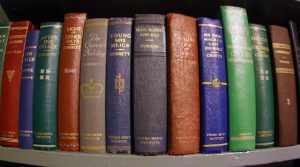
The Books
Here, the books are not catalogued by the Dewey Decimal System.
“We have our very own system and original card catalog that is nowhere else in the world,” Garlick says.
William Alanson Borden implemented the system. He was the library’s first professionally trained librarian, serving from 1887 to 1910, and he experimented with new technologies and patented new categories. Although the classification system was adapted in India for some time, today it can only be found at The Institute Library.
The system allows the library to provide “a living collection,” expanding its particular subsets regularly with purchased and donated books that reflect members’ interests, Garlick says.
The focus is on adult fiction and nonfiction, from classics to new novels, including romance, murder mysteries, contemporary bestsellers, biographies, science, travel, and culture.
The oldest volumes in the collection are reference books that are still recorded in handwritten card catalogues. These include very rare phone directories of New Haven workers, containing detailed information on the people and their jobs – the Facebook of its time.
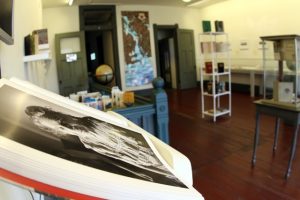
The Art
The designated second-floor art gallery is an exhibition space for visual art, presenting four to six exhibits a year with strong connections to words, language and literature.
Exhibitions are organized by Martha Lewis, the library’s curator in residence for the past seven years, who does this big job for no salary simply because she loves and believes in the library.
“I do my own graphic design, physically put up the exhibits, and select the artists,” she says. “Valerie [Garlick] helps me a lot, [along] with the kindness of other artists and preparators.”
An artist herself, Lewis says when she took over as the gallery’s second curator, “The one thing I wanted to do, partly because of my own interest in books and the way my work related to books in the past, was to do exhibits that connected the collections downstairs with the exhibits upstairs in some way or another.”
This past summer’s show, “Wish You were Here,” is an example. Dedicated to armchair travel, vacations, and adventures elsewhere, it featured the work of 12 artists in conjunction with selected travel books, atlases, and other vintage materials from the library’s historic collection.
“As [both] a curator and artist, I find shows very flat where I can tell a curator has an idea and ticks the boxes off to get it done,” Lewis says.
“I do have an idea before I start a show, and then I actively look to find things I’m interested in and see how they’re going to have a visual conversation.”
She adds, “I have an open call because I believe in democratic process, and all young artists deserve a chance. The healthiest thing for local artists is to compete with artists in the global arena, and I always try to get a couple of internationally known artists.”
Although other libraries have art exhibits and show objects from their collections, Lewis thinks The Institute Library shows are unique.
“Our openings are wildly fun,” she says. “We try to have food that relates to the theme. We also have popular artist-led tours during the openings.”
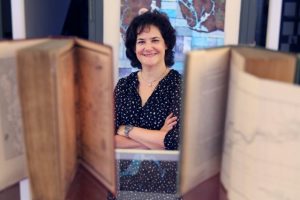
Supporting Characters
Certainly, Garlick admits, there are financial challenges to keeping the library running.
“We own this building [so] we get some rent,” she says. “Membership dues count for a lot and donations from people who believe in what we’re doing. We receive support through grants and do several annual fundraisers.”
Lewis and Garlick say one of the biggest challenges is the age of the building.
“It’s the challenge of people using the space and the space being worn down by the use,” Lewis says. “We want people in here and enjoying it, but we also want to be able to preserve and maintain it for the future. That’s what we’re here for: stewardship.”
The organization is currently in the midst of a building campaign whose purpose is to “restore and revitalize” the four-story structure. It’s seeking private and institutional funding – as well as community support – for critical repairs to the infrastructure, energy efficiency updates, and accessibility improvements. On the list of needed repairs are a degraded wooden carrying beam on the third floor, ice-damaged interior and exterior brick, and interior plaster. The library would also like to install an insulated roof, a hard-wired fire-suppression system, a security surveillance system, and an ADA-compliant entrance hall, elevator and bathrooms.
In addition to donors, volunteers are essential for survival.
“We have nine core volunteers who greet visitors at the door and know our collections inside and out and give tours,” Garlick says. “They range from students to retirees: from people who love books to writers and artists.”
Carol Snyder of North Haven has been volunteering at the library for two years and says there isn’t a minute she doesn’t enjoy being there. She works one afternoon a week, staffing the front desk and helping out on projects and special events.
“The Institute has a real personality – quirky, amusing, the holder of almost two centuries of information and wisdom,” Snyder says. “It’s great fun watching new visitors discover the place … seeing their eyes bug out at the reading nooks and crannies that look like a setting for a Victorian novel; at the card catalogue with beautifully scripted entries from the 1800s; and at all the wonderful reminders of the Institute’s nearly two centuries in New Haven.
“And where else,” Snyder asks, “could I volunteer and get to witness the return, in March 2018, of the Institute’s copy of ‘The Trawler’ by James B. Connolly? It had been checked out and overdue since Jan. 16, 1915!”
Photography by Stan Godlewski



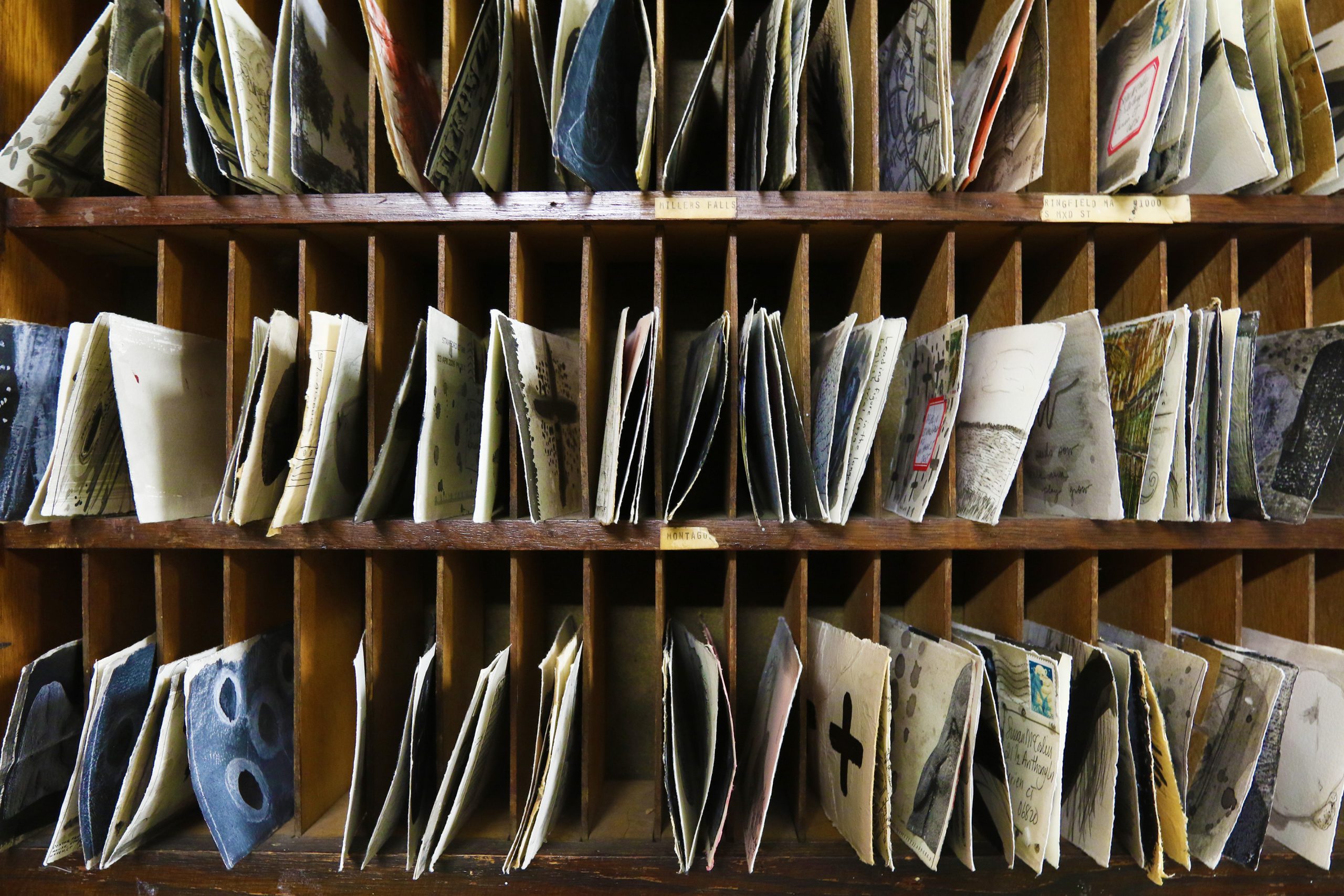



More Stories
Haunted Apples and Bewitched Beer
Gayle King speaks to Dennis House
Everybody Remembers Their First Outdoor Concert